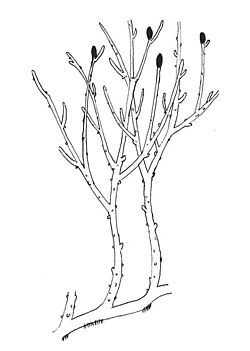User:Abyssal/Portal:Devonian
IntroductionThe Devonian (/dəˈvoʊni.ən, dɛ-/ də-VOH-nee-ən, deh-) is a geologic period which was a system of the Paleozoic era during the Phanerozoic eon, spanning 60.3 million years from the end of the preceding Silurian period at 419.2 million years ago (Ma), to the beginning of the succeeding Carboniferous period at 358.9 million years ago. It is named after Devon, South West England, where rocks from this period were first studied. The first significant evolutionary radiation of life on land occurred during the Devonian, as free-sporing land plants (pteridophytes) began to spread across dry land, forming extensive coal forests which covered the continents. By the middle of the Devonian, several groups of vascular plants had evolved leaves and true roots, and by the end of the period the first seed-bearing plants (pteridospermatophytes) appeared. This rapid evolution and colonization process, which had begun during the Silurian, is known as the Silurian-Devonian Terrestrial Revolution. The earliest land animals, predominantly arthropods such as myriapods, arachnids and hexapods, also became well-established early in this period, after beginning their colonization of land at least from the Ordovician period. (Full article...) Selected article on the Devonian world and its legacies
The annelids are a large phylum of segmented worms, with over 2,000 modern species including ragworms, earthworms and leeches. They are found in marine environments from tidal zones to hydrothermal vents, in freshwater, and in moist terrestrial environments. The basic annelid form consists of multiple segments, each of which has the same sets of organs and, in most polychaetes, a pair of parapodia that many species use for locomotion. Septa separate the segments of many species, but are poorly defined or absent in some. Septa also enable annelids to change the shapes of individual segments, which facilitates movement by "ripples" that pass along the body or by undulations. Although many species can reproduce asexually and use similar mechanisms to regenerate after severe injuries, sexual reproduction is the normal method in species whose reproduction has been studied.
Since annelids are soft-bodied, their fossils are rare – mostly jaws and the mineralized tubes that some of the species secreted. Although some late Ediacaran fossils may represent annelids, the oldest known fossil that is identified with confidence comes from about 518 million years ago in the early Cambrian period. Fossils of most modern mobile polychaete groups appeared by the end of the Carboniferous, about 299 million years ago. Scientists disagree about whether some body fossils from the mid Ordovician, about 472 to 461 million years ago, are the remains of oligochaetes, and the earliest certain fossils of the group appear in the Tertiary period, which began 65 million years ago. (see more...) Did you know?
Need help?Do you have a question about Abyssal/Portal:Devonian that you can't find the answer to? Consider asking it at the Wikipedia reference desk. Selected image
Selected article on the Devonian in human science, culture and economics
Paleontology or palaeontology (/ˌpeɪliɒnˈtɒlədʒi, ˌpæli-, -ən-/) is the scientific study of prehistoric life. It includes the study of fossils to determine organisms' evolution and interactions with each other and their environments (their paleoecology). As a "historical science" it attempts to explain causes rather than conduct experiments to observe effects. Paleontological observations have been documented as far back as the 5th century BC. The science became established in the 18th century as a result of Georges Cuvier's work on comparative anatomy, and developed rapidly in the 19th century. The term itself originates from Greek: παλαιός (palaios) meaning "old, ancient," ὄν, ὀντ- (on, ont-), meaning "being, creature" and λόγος (logos), meaning "speech, thought, study".
Paleontology lies on the border between biology and geology. It now uses techniques drawn from a wide range of sciences, including biochemistry, mathematics and engineering. Use of all these techniques has enabled paleontologists to discover much of the evolutionary history of life, almost all the way back to when Earth became capable of supporting life, about 3,800 million years ago. As knowledge has increased, paleontology has developed specialized sub-divisions, some of which focus on different types of fossil organisms while others study ecology and environmental history, such as ancient climates. Body fossils and trace fossils are the principal types of evidence about ancient life, and geochemical evidence has helped to decipher the evolution of life before there were organisms large enough to leave fossils. (see more...) GeochronologyEpochs - Early Devonian - Middle Devonian - Late Devonian Landmasses - Baltica - Laurentia - Euramerica - Gondwana Fossil sites - Grenfell fossil site History - The Great Devonian Controversy SubcategoriesQuality ContentFeatured Devonian articles - None Things you can doRelated contentAssociated WikimediaThe following Wikimedia Foundation sister projects provide more on this subject:
|






















